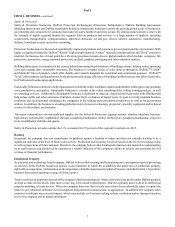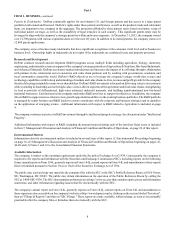DuPont 2015 Annual Report Download - page 12
Download and view the complete annual report
Please find page 12 of the 2015 DuPont annual report below. You can navigate through the pages in the report by either clicking on the pages listed below, or by using the keyword search tool below to find specific information within the annual report.Part I
ITEM 1A. RISK FACTORS, continued
11
There can be no assurance that the expected benefits of the Mergers, including the Business Separations, will occur or be
fully or timely realized.
The success of the Mergers will depend, in part, on the combined company’s ability to successfully combine the businesses of
DuPont and Dow. If the combined company is not able to successfully combine the businesses of DuPont and Dow in an efficient
and effective manner, including if the intended Business Separations are delayed or ultimately not consummated, the anticipated
benefits, synergies operational efficiencies and cost savings may not be realized fully or at all, or may take longer to realize than
expected, and the value of common stock, the revenues, levels of expenses and results of operations of the combined company
may be adversely affected.
The combination of two independent businesses is a complex, costly and time consuming process, and the management of the
combined company may face significant challenges in implementing such integration, including, without limitation:
• the diversion of management’s attention from ongoing business concerns and performance shortfalls at one or both of
the companies as a result of the devotion of management’s attention to the Mergers;
• ongoing diversion of the attention of management from the operation of the combined company’s business as a result of
the intended business separations;
• difficulties in achieving anticipated cost savings, synergies, business opportunities and growth prospects;
• challenges of managing a larger combined company addressing differences in business culture and retaining key personnel;
• the possibility of faulty assumptions underlying expectations regarding the integration process, including with respect to
the intended Business Separations;
• unanticipated issues in integrating information technology, communications programs, financial procedures and
operations, and other systems, procedures and policies;
• unanticipated changes in applicable laws and regulations;
• managing tax costs or inefficiencies associated with integrating the operations of the combined company and the intended
Business Separations;
• coordinating geographically separate organizations; and
• unforeseen expenses or delays associated with the Mergers.
Some of these factors will be outside of the control of management and any one of them could result in increased costs and diversion
of management’s time and energy, as well as decreases in the amount of expected revenues which could materially impact the
company’s business, financial conditions and results of operations. Difficulties in the integration process and other disruptions
resulting from the Mergers, could adversely affect the combined company’s relationships with employees, suppliers, customers,
distributors, licensors, and other stakeholders and could harm the reputations of DuPont, Dow and the combined company.
If the combined company is not able to adequately address integration challenges, the combined company may be unable to
integrate successfully DuPont’s and Dow’s operations, effect the intended business separations or to realize the anticipated benefits
of the transactions. In addition, the actual integration may result in additional and unforeseen expenses, and the anticipated benefits
of the integration plan may not be realized. Actual growth and cost savings, if achieved, may be lower and may take longer to
achieve than anticipated.
DuPont will be subject to business uncertainties and contractual restrictions until the Mergers are consummated.
Uncertainty about the effect of the Mergers on employees, suppliers, customers, distributors, licensors and licensees as well as
regulatory permits, licenses, contracts and other agreements, particularly for which the Mergers could be deemed a “change-in-
control” under the applicable terms and conditions may have an adverse effect on DuPont, Dow and consequently on the combined
company. Changes to existing business relationships, including termination or modification, could negatively affect each of
DuPont’s and/or Dow's revenues, earnings and cash flow, as well as the market price of its common stock. These uncertainties
may impair each party’s ability to attract, retain and motivate key personnel until the consummation of the Mergers, and could
cause suppliers, customers and others that deal with the parties to seek to change existing business relationships with them.
Retention of employees could be challenging during the pendency of the Mergers due to uncertainty about their future roles. If
key employees depart because of issues related to the uncertainty and difficulty of integration or a desire not to remain with the
businesses, the combined company’s business following the consummation of the Mergers could be negatively impacted. Further,
no assurance can be given that the combined company will be able to attract or retain key management personnel and other key
employees of DuPont and Dow to the same extent that DuPont and Dow have previously been able to attract or retain their
employees.
























